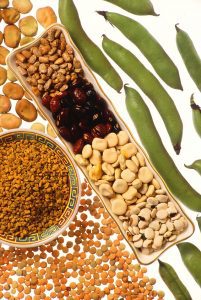Lifestyle modifications including diet can help
By David Dunaief, M.D.

In my practice, many patients have resisted telling me they suffered from erectile dysfunction (ED). However, it’s a common problem. Because it can indicate other medical issues, it’s important that you share this information with your doctor.
ED affects about 24 percent of men, on average. If it occurs less than 20 percent of the time, it is considered normal; however, if it occurs more than 50 percent of the time, you should seek help (1).
Of course, there are oral medications for ED. You’ve probably seen the ads for approved medications, including sildenafil (Viagra, or the “little blue pill”), tadalafil (Cialis), vardenafil (Levitra, Staxyn), and avanafil (Stendra). They work by causing vasodilation, or enlargement of blood vessels, which increases blood flow to the penis. Unfortunately, this does not solve the medical problem, but it does provide a short-term solution for those who are good treatment candidates.
ED’s prevalence generally increases with age. An analysis of the 2021 National Survey of Sexual Wellbeing found that ED affected 12.7 percent of 35-44-year-olds, increased to 25.3 percent of 45-54- year-olds, 33.9 percent of those aged 55-64, 48 percent of those aged 65-74, and 52.2 percent of those aged 75 and older (2).
So, what contributes to the increase as we age? Disease processes and drug therapies.
What is the connection between medical conditions and ED?
Chronic diseases can contribute significantly to ED. ED might also be an indicator of disease. Typical contributors include metabolic syndrome, diabetes, high blood pressure, cardiovascular disease and obesity. In the Look AHEAD trial, ED had a greater than two-fold association with hypertension and a three-fold association with metabolic syndrome (3). In another study, ED was associated with a 2.5-times increase in cardiovascular disease (4).
Patients with ED had significantly more calcification, or atherosclerosis, in their arteries when compared to a control group in a randomized clinical trial (RCT) (5). They were also more than three times as likely to have severe calcification. In addition, they had more inflammation, measured by C-reactive protein.
Which medications contribute to ED?
About 25 percent of ED cases are thought to be associated with medications, such antidepressants, NSAIDs (e.g., ibuprofen and naproxen sodium), and hypertension medications. Unfortunately, the most common antidepressant medications, SSRIs, have significant impacts on ED.
The California Men’s Health Study, with over 80,000 participants, showed that there was an association between NSAIDs and ED, with a 38 percent increase in ED in patients who use NSAIDs on a regular basis (6). The authors warn that patients should not stop taking NSAIDs without consulting their physicians.
Also, high blood pressure drugs have a reputation for causing ED. A meta-analysis of 42 studies showed that beta blockers have a small effect, but thiazide diuretics (water pills) more than doubled ED, compared to placebo (7).
How can diet affect ED?
The Mediterranean-type diet has been shown to treat and prevent ED. It’s a green leafy alternative to the little blue pill. Foods are rich in omega-3 fatty acids and high in monounsaturated fats and polyunsaturated fats, as well as fiber. Components include whole grains, fruits, vegetables, legumes, walnuts, and olive oil.
In two RCTs lasting two years, those who followed a Mediterranean-type diet experienced improvements in their endothelial functioning (8, 9). They also experienced both lower inflammation and lower insulin resistance.
In another study, those who had the highest compliance with a Mediterranean-type diet were significantly less likely to have ED, compared to those with the lowest compliance (10). Even more impressive was that the group with the highest compliance had a 37 percent reduction in severe ED versus the low-compliance group.
A study of participants in the Health Professionals Follow-up Study looked closely at both the Mediterranean-type diet and the Alternative Healthy Eating Index 2010 diet, which emphasized consuming vegetables, fruits, nuts, legumes, and fish or other sources of long-chain fats, as well as avoiding red and processed meats (11). At this point, it probably won’t surprise you to hear that the greater participants’ compliance with either of these diets, the less likely they were to experience ED.
References:
(1) clevelandclinic.org. (2) J Sex Med. 2024;21(4): 296–303. (3) J Sex Med. 2009;6(5):1414-22. (4) Int J Androl. 2010;33(6):853-60. (5) J Am Coll Cardiol. 2005;46(8):1503. (6) Medicine (Baltimore). 2018 Jul;97(28):e11367. (7) JAMA. 2002;288(3):351. (8) Int J Impot Res. 2006;18(4):405-10. (9) JAMA. 2004;292(12):1440-6. (10) J Sex Med. 2010 May;7(5):1911-7. (11) JAMA Netw Open. 2020 Nov 2;3(11):e2021701.
Dr. David Dunaief is a speaker, author and local lifestyle medicine physician focusing on the integration of medicine, nutrition, fitness and stress management. For further information, visit www.medicalcompassmd.com or consult your personal physician.

















